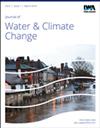Comparison between methods to predict climate change impacts on tropical shallow lakes
IF 3.1
4区 环境科学与生态学
Q2 WATER RESOURCES
引用次数: 0
Abstract
Abstract Inland waters play a key role in climate change studies, but choosing the correct tool to represent them is challenging. This paper discusses tools’ applicability for predicting the impact of climate change on a lake's hydrodynamics. It aims to help determine the most suitable method to utilize. Three different tools, capable of representing the lake's hydrodynamics, were built and evaluated through the required input data quantity, the lake's hydrodynamic representation, and time consumption. Two climate change scenarios were simulated using the thermal stability curve, a unidimensional model (GLM), and a 3D mathematical model (Delft3D). The results were consistent, indicating an increase in the lake's temperature and the required energy to break the stratification, altering the lake's thermal patterns. The stability curve requires minimum input data and, with little computing time, can cover a larger simulation window. The unidimensional model requires more input data and knowledge, but with little simulation time, it shows the temperature profile, while the three-dimensional model provides gains in spatial variability representation; however, it needs more input data and advanced knowledge and is time-consuming. In lake management, it will be appropriate to combine the methods, using the curve to analyse the trend and delimitate the period for detailed study.预测气候变化对热带浅湖影响的方法比较
内陆水域在气候变化研究中发挥着关键作用,但选择正确的工具来代表它们是具有挑战性的。本文讨论了气候变化对湖泊水动力影响预测工具的适用性。它的目的是帮助确定最合适的方法。通过所需的输入数据量、湖泊的水动力表示和时间消耗,构建并评估了三种能够表示湖泊水动力的不同工具。采用热稳定性曲线、一维模型(GLM)和三维数学模型(Delft3D)对两种气候变化情景进行了模拟。结果是一致的,表明湖泊的温度和打破分层所需的能量增加,改变了湖泊的热模式。稳定性曲线需要最少的输入数据,并且计算时间少,可以覆盖更大的模拟窗口。一维模型需要更多的输入数据和知识,但模拟时间短,能较好地反映温度分布,而三维模型在空间变异性表征方面有所提高;然而,它需要更多的输入数据和高级知识,并且耗时。在湖泊管理中,宜将这两种方法结合起来,用曲线分析趋势,并划定时间段进行详细研究。
本文章由计算机程序翻译,如有差异,请以英文原文为准。
求助全文
约1分钟内获得全文
求助全文
来源期刊

Journal of Water and Climate Change
WATER RESOURCES-
CiteScore
4.80
自引率
10.70%
发文量
168
审稿时长
>12 weeks
期刊介绍:
Journal of Water and Climate Change publishes refereed research and practitioner papers on all aspects of water science, technology, management and innovation in response to climate change, with emphasis on reduction of energy usage.
 求助内容:
求助内容: 应助结果提醒方式:
应助结果提醒方式:


